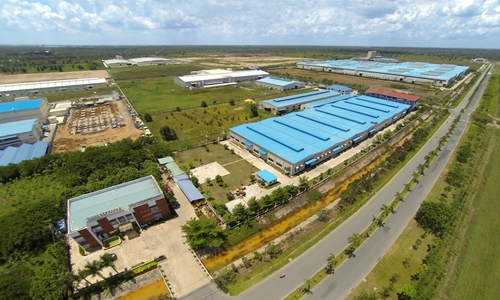HOME >> CHINA
Feature: Chinese-invested industrial park in Vietnam brings opportunities
Source:Xinhua Published: 2020/1/18 15:25:04

Photo: Xinhua
In 2008 when she graduated from university, Tran Thi Ngoc Dung made a bold decision to leave Vietnam's economic center Ho Chi Minh City to work in a Chinese-invested industrial park in the rural south.
"It made me change from nobody to somebody," said Dung, who is now a department director at Long Jiang Industrial Park.
In Tan Phuoc District in south Vietnam's Tien Giang Province, an eye-catching billboard in Vietnamese, Chinese and English marks the destination for flocks of motorbike commuters on weekday mornings.
Once a vast land of pineapple fields, the 600-hectare industrial park filled with busy roads and factories is now home to 45 businesses largely from Vietnam and China, offering multiple opportunities.
"Many local people, who were farmers and relied on good weather to feed themselves, now have stable jobs and fairly good incomes," said Doan Van Nen, a former district official.
Currently, more than 30 companies and 23,000 workers operate in the park, prompting neighborhood businesses in the catering, grocery, and property sectors to flourish. Under full operation, it's possible for the park's production to total over 4 billion US dollars annually.
One of the park's latest residents, the Chinese-invested Advance Tyre (Vietnam) company, held its factory's groundbreaking ceremony there in December, with an up-front investment worth 220 million US dollars.
In 2018, Long Jiang was awarded the title of Model Enterprise of Tien Giang Province.
Notably, all businesses in the industrial park are required to be eco-friendly and are subject to tough environmental regulations.
"One of the very first facilities we built in the park was an advanced sewage disposal system," said Yu Suo, president of Long Jiang Industrial Park Development Company.
And while environmental protection has always been a top priority, he noted, corporate social responsibility plays just as important a part.
In recent years, Long Jiang has donated more than 800,000 dollars to help local residents with infrastructure construction and other projects. "We often talk with locals and get to know about their needs," Yu said. "Local residents are the eventual beneficiaries of the park's development."
Dung, who majored in Chinese language at university, is running language training courses with her husband alongside her daytime job.
"I teach Vietnamese to Chinese people and teach Chinese to Vietnamese workers at Long Jiang," she said, adding that many of her students are now able to communicate with and understand their foreign colleagues better.
Long Jiang's Chairman Weng Mingzhao said Chinese and Vietnamese workers get along well in the industrial park, where a number of Vietnamese people work in management positions.
He also said Long Jiang plans to introduce more investment projects, as well as new technologies and management methods, to Vietnam.
This year marks the 70th anniversary of diplomatic ties between China and Vietnam. "The two countries are complimentary in trade, and have similar cultural backgrounds," Weng noted.
"We hope to bring more tangible benefits to Vietnamese people, help further promote the friendship between the two peoples, and see increased long-term cooperation," he added.
RELATED ARTICLES:
Posted in: DIPLOMACY